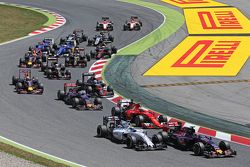Revealed: The true cost of customer cars
The Formula 1 Strategy Group made some wide-ranging decisions last week, including raising the subject of customer cars. Kate Walker reveals the real numbers behind such moves.

Photo by: XPB Images

















The decision taken last week by the F1 Strategy Group to begin a customer car study borders on the redundant, as members of the F1SG have had the relevant data to hand since the McKinsey & Company report into F1 cost reduction was circulated in the pre-season.
While the original McKinsey report made no specific mention of customer cars, one of its key objectives was to propose a viable cost reduction plan that relied heavily on an increased list of standardised parts, and which included proposals for a standardised chassis.
Following discussions with the teams, FOM, and the FIA, and careful assessment of both publicly-available and traditionally-confidential team financial data, the McKinsey report proposed three different cost-cutting scenarios and the likely savings to result from each option.
McKinsey identified that the difference between income and expenditure for a smaller team was in the region of £25million to £30million, and so targeted savings in that region – a sum, incidentally, that is roughly equivalent to a team’s total spend on the car minus power unit.
Cost savings on components
To improve the potential for cost saving on components, a range of options were considered, from increasing the list of common parts to include items like the survival cell to standardising either the design or supplier of components such as gearboxes. The impact each change might have on the show was considered, with the focus on the inner workings of the cars.
The likely financial impact of each change on teams was also measured – a standardised survival cell would save a team like Force India or Sauber between £1-2million a year, for example, while a team such as Mercedes or Ferrari would save less than £100,000.
In order to achieve the target savings of around £30million a year, further cost reductions had to be examined, and it is here that Strategy Group ideas such as the windtunnel ban, a single chassis supplier, and single-spec cars for interested customer teams come into play.
Interestingly, references to both single chassis and spec cars specify that the items are “not [to be] provided by a top team”.
Expanding the list of common parts and further limiting staffing levels, aero development spends, and simulator time could lead to savings of between £12-14million a year for the smaller teams, and so is far from being enough to keep the wolves from the door.
As a result, more extreme cost cutting ideas had to be costed and the savings estimated.
At this point it should be noted that an equitable division of the monies available to the teams would net each one just shy of the £90 million it is estimated to cost to run a competitive outfit. But that option was not one given serious consideration at Biggin Hill on Thursday.
How small teams could halve their costs
The cost of removing the chassis from the list of parts a team must construct themselves? £13-16million per annum to a small team.
The savings generated by buying in a rolling chassis developed by a single supplier? £18-21m, with the consolation of designing your own bodywork.
And the final item on the list? Savings of £32-38m a year for single-specification cars (including bodywork) available for sale to interested teams.
The cost of losing one’s status as a constructor and the raison d’etre in Formula 1? Priceless.
When further scenarios – including common aero testing – are taken into account, the Strategy Group’s proposals were estimated by McKinsey to save the smaller teams up to £48m a year, or more than half their current operating budgets.
But each of the proposals were also assessed for the likely impact that each would have on the sport’s popularity – F1 must retain its association with engineering, technology, and automotive development while producing good racing that ensures it remains attractive to both fans and sponsors.
It is here that the more extreme scenarios were found to have a negative impact.
Options not worth the bother
Standardised gearboxes and the like were judged to have little impact on the sport’s engineering or popular appeal, while windtunnel bans and reduction on the introduction of new parts in-season raised concerns that if poor performance were locked in early on the sport would be less engaging.
As for the big guns, the spec cars and chassis, the report points out that these options risk a “lack of public interest in smaller teams with similar cars”, something that would have a negative impact on team budgets as sponsors also showed little to no interest in the look-a-likes at the back of the pack.
It is something the Strategy Group would be well served by remembering if they are to press ahead with the customer car scenario.
Be part of Motorsport community
Join the conversationShare Or Save This Story
Subscribe and access Motorsport.com with your ad-blocker.
From Formula 1 to MotoGP we report straight from the paddock because we love our sport, just like you. In order to keep delivering our expert journalism, our website uses advertising. Still, we want to give you the opportunity to enjoy an ad-free and tracker-free website and to continue using your adblocker.















Top Comments